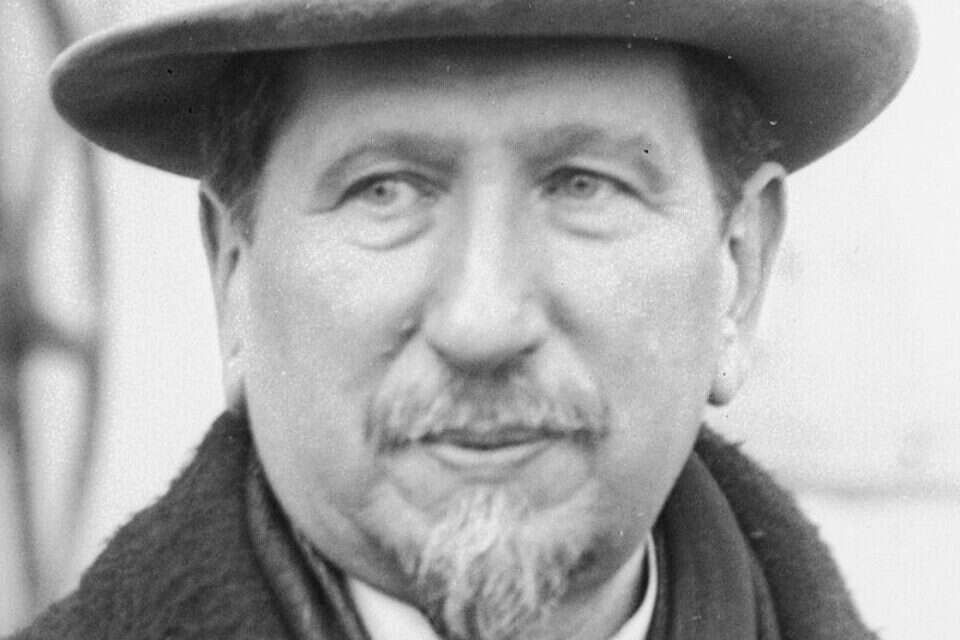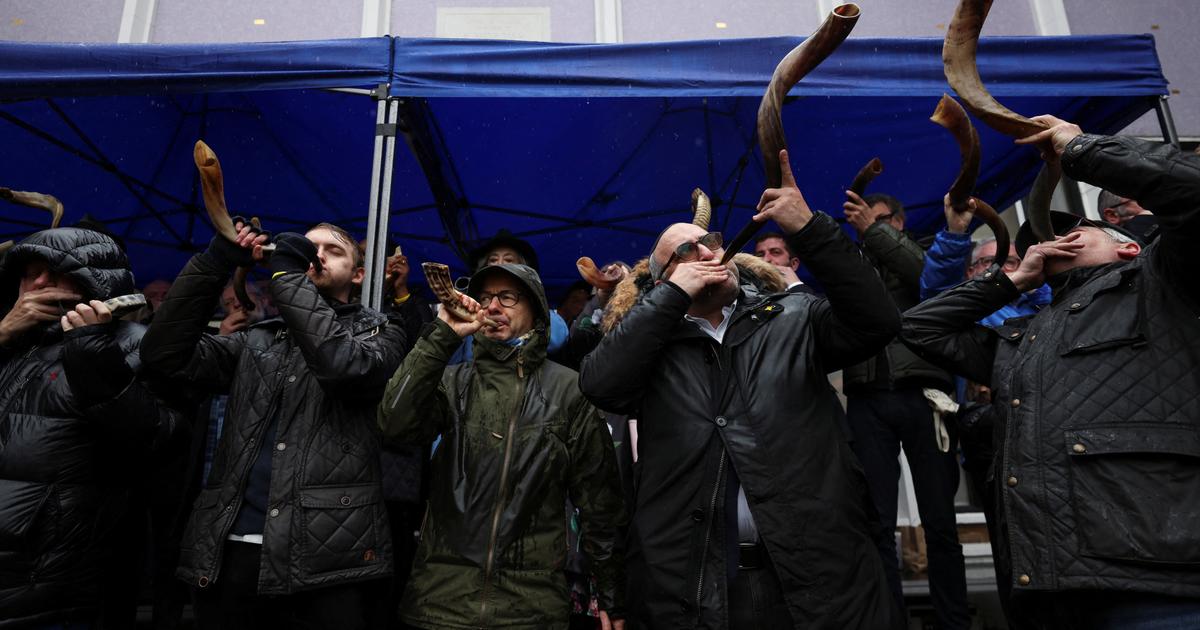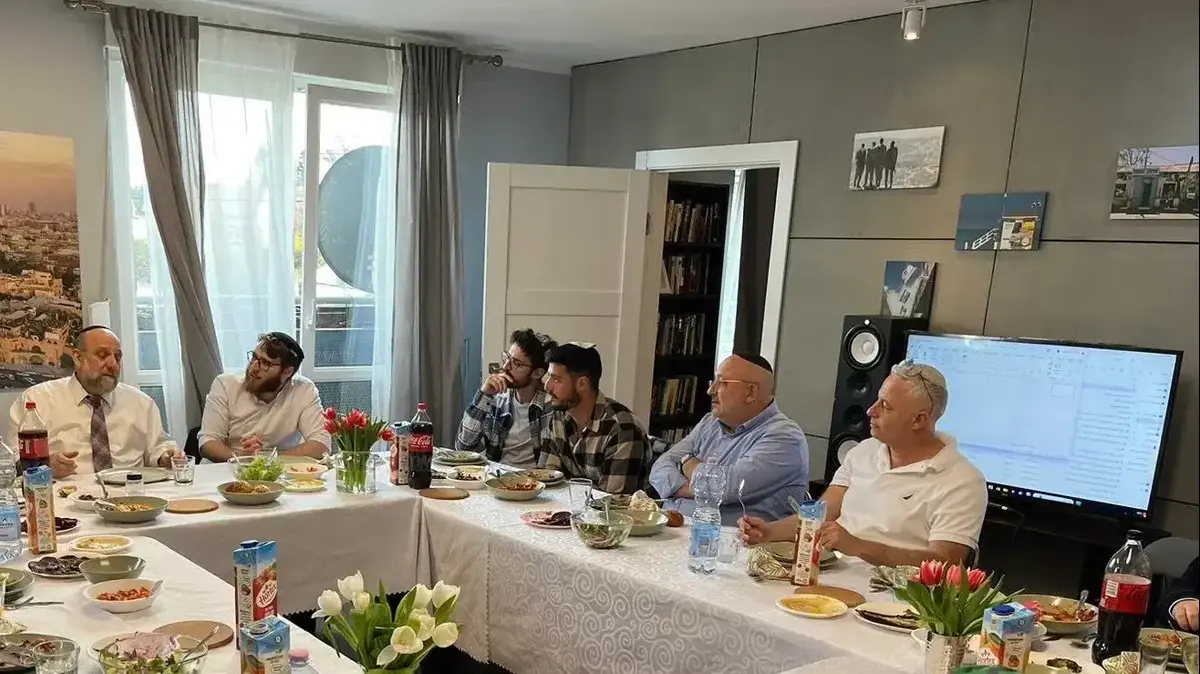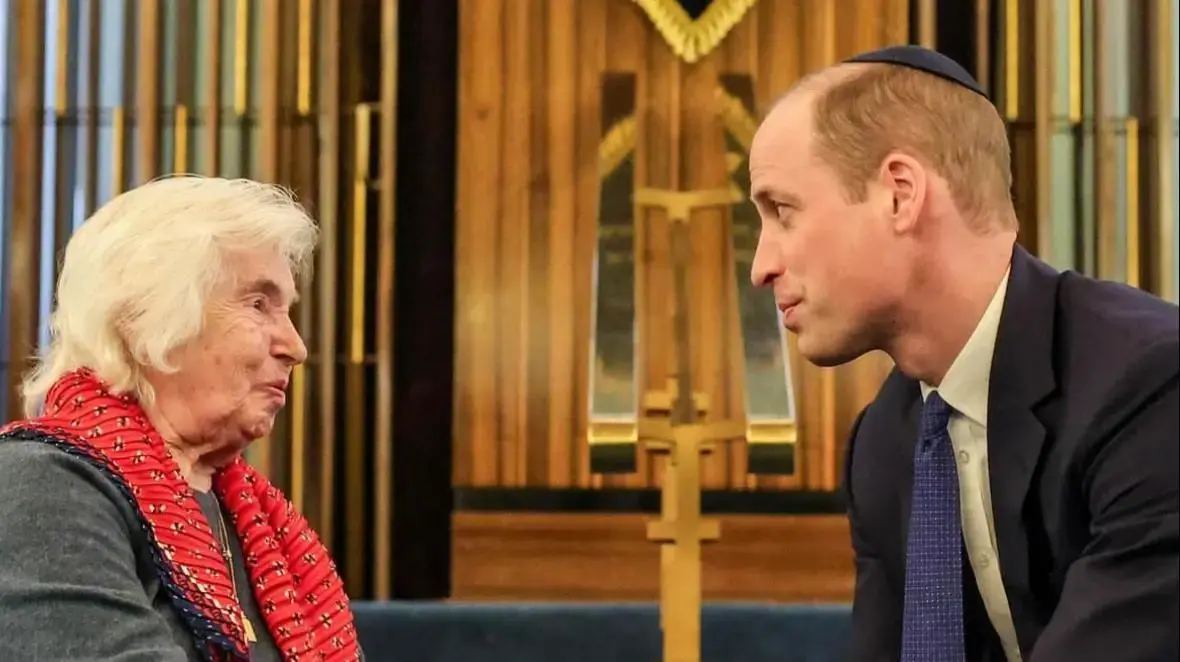In 1893, the Zionist-Utopian novel by Max Osterberg-Warkoff, "The Kingdom of the Jews in 6000 (2241 AD), was published in German."
The book begins with the solemn unveiling of the statue of William Blackstone, the founder of that kingdom.
Blackstone, was a Christian Zionist who actually motivated the American authorities in 1891 in favor of establishing a Jewish state in Palestine.
Due to his efforts, within a few months, President Harrison invited, among others, the Jerusalem consul to draft an official report and the ambassador in St. Petersburg to consult with the Russian foreign minister on the matter.
Benjamin Zeev Herzl, author of the book The State of the Jews (1896), discovered Osterberg-Warkoff's utopian work only in 1899.
"He sent him a warm letter, promising to express his appreciation for the utopian novel in his writing," notes Professor Miriam Eliav-Feldon.
Already at that time Herzl formulated his Zionist text, which he finally published in 1902 under the title Altneuland, meaning "old-new land."
It is interesting that in that year a translation of the book into Hebrew (in Warsaw) was published and the agile translator was none other than Nahum Sokolov, a Polish Jew who was known at the time as the editor-in-chief of the Hebrew magazine "The Siren" published in Warsaw.
Sokolov called for his translation of a book called "Tel Aviv."
The word "Tel" means an ancient settlement built on a hill and together with the word "Aviv" the meaning of the name is actually "old-new".
That is, the largest city in Israel owes its name to Sokolov, when he himself was born in the Polish city of Vyshgorod and it is no coincidence that its name in Hebrew means "Tel".
The story of Nahum Sokolov - a key figure in the history of the Hebrew press, who was a partner in compiling the Balfour Declaration and president of the World Zionist Organization - begins on a tell on the banks of the Vistula River.
He spent his early childhood years in Vyshgorod and later moved to nearby Plock located on the same line down the river.
There grew up the man who later in his life negotiated for the "establishment of a national home for the Jewish people in Palestine" with the Pope and with the most important diplomats of France and the British Empire.
A mound on the banks of the Vistula River
The town square in Vyshgorod does not arouse extraordinary admiration, neither in terms of its size nor in its glory.
However, compared to similar squares found in other towns in northern Poland, surrounded by colorful two-story houses with sloping roofs, it differs in one essential feature - the square in Vyshgorod has only three sides.
The fourth side is unbuilt and leads directly to an observation point from which there is a beautiful view of the Vistula, the Kampa district and the Mazovia plain.
"A kind of regional triangle has been formed here, on one side of which is a large valley, into which the ruins of the local synagogue were thrown during the war," says Zdzyslaw Leszczynski, director of the Vistula Museum in Vyshgorod, located in the area where Jews lived in the late 19th century.
Nahum Sokolov was born in this area in 1859. "On the other side, next to the palace was Vishlana Street followed by Ravovska Street, from which it was possible to exit to a gate that led to Kahlana Street which no longer exists, which eventually led to the synagogue," he adds.
Herzl on his way to visit Eretz Israel, Photo: GPO
The synagogue does not exist today as it was destroyed by the Germans during World War II, while the Jews themselves were forced to bury its ruins in a nearby valley.
Today, in the area behind the residences you can find a vegetable garden synagogue, where there are sometimes remains in the ground that are transferred to the museum, and in the area of the old square there are crumbling garages and small workshops.
On the façade of only one house in Vyshgorod, symbols of the Star of David survived, which were not unusually removed during the various renovations made after the war.
It is not known exactly where Nahum Sokolov was born on January 10, 1859. Leszczynski emphasizes that we can only guess which houses and fragments belong to that period, since they were built of bricks taken from the ruins of the 14th-century Vyshgorod Castle.
To this day under the cracked plaster in the stairwells or basements of the houses one can find these bricks made by hand in the Middle Ages.
However, it is known that Nahum Sokolov spent the first five or six years of his life in Vyshgorod and he remembered that period fondly until the end of his life.
He recalled playing knights' games with his friends in the square in front of the synagogue with sticks used as swords, and it is possible that even then the boy, who belonged to a wealthy Jewish family, began to consider himself a knight, which may explain how other Zionist activists joked that Sokolov was the only one. Who considered himself a Polish nobleman and even acted alike.
Vyshgorod, Photo: Silentgringo, Wikipedia
The Sokolov family lived in Vyshgorod from the beginning of the 19th century.
Nahum's grandfather was a rabbi and he moved to Mazovia from Podlasia.
As a child, Nahum lived until the events of the January Uprising, during which battles took place between the Polish rebels and the Russian army in the vicinity of Vyshgorod.
The city's Jewish residents unequivocally supported the Polish side of the uprising, about which Sokolov later told his children.
Presumably, the fact that he was a direct witness to the Polish pursuit of freedom and independence shaped his imagination and contributed to his devotion to the goal of establishing a state for the Jews.
Sokolov considered himself as Polish almost as much as he was a Jew.
He spoke Polish, gave his children names like Maria, Florian or Selena and raised them in a Polish-speaking home.
To the end of his life he kept his diary, much of which was recorded after he moved to London, in Polish.
His time in Plock
In 1864 or 1865, Sokolov's parents moved to the town of Plock, which was not far from Vyshgorod, but was larger and richer. This city will in the future give their talented son opportunities that will clearly exceed their expectations. The house where they once lived is now abandoned and prone to collapse, standing in the same place in the town square and surrounded by a crumbling fence. It is one of several dilapidated dwellings located in the restored square in the center of which is a beautiful fountain and on one side stands a magnificent structure belonging to the municipal authorities.
Here the young Sokolov learned languages independently and "secretly", as his son Florian explains in his father's biography, published in Poland in 2006 with an extensive introduction by Prof. Andrzej A. Zeiba. Over time, however, the skills of the young polyglot caught the attention of local authorities. When he was 10, Nahum was introduced to Governor Michael Wrangel, who offered him a scholarship to study at the Plock Gymnasium, which was considered one of the best in the Russian-occupied territory in the second half of the 19th century. The possibility that the talented boy would devote his time to studying Greek, Latin and history, instead of studying the holy books that would allow him to become a respected rabbi, provoked strong opposition from Sokolov's grandfather, who was a decisive voice on the question of his upbringing. However, the dilemma was resolved through a compromise, when it was decided that Nahum would receive private lessons from high school teachers, who provided him not only with a thorough education but also apparently shaped his inquisitive and analytical mind that was able to describe reality soberly and objectively.
"Plock was one of the oldest cities in Poland inhabited by Jews and under Sokolow they made up about a third of the population," notes Piotr Dombrowski, founder and president of the Novikskom Foundation, which together with his wife Gabriela published the guide following the Jews of Płock (Śladami Płockich Żydów).
- The people who lived here were poor people and even very poor. The Jewish Quarter was often tormented by fires that broke out in the wooden buildings that were here in the early 19th century. In the interwar period, Plock was a city of rich art life. Although it had its difficulties, it was a bustling city in the second half of the 19th century and this must have had an impact on Sokolov, because its horizons went far beyond education and life limited to the Jewish Quarter.
Nahum Sokolov always saw Plock as his hometown.
Florian stated: "I remember that the phrase 'native of Plock' was always said affectionately and warmly in my parents' house and that is the best confirmation of that."
Indeed, in his home in the Old Town Square, Soklov had a library in which he would sink into reading and experience an "greater elation than in the British Museum," as he recalled years later.
Beginning in the field of journalism
The breakthrough of Nahum Sokolov as a journalist occurred in 1876, when he was 17, in one of the most important Hebrew journals of the time - The Siren.
The paper's editor-in-chief - Haim Zelig Slonimski, the grandfather of the famous Anthony - noticed the boy's potential and actively supported his development over the following years.
Only memories and names of streets remain from the Jewish quarter of Plock. From the Old Town Square, Yeruzulimska Street ("Jerusalem Street") leads to Singoglana Street ("Synagogue Street"), where there is an empty square where the Great Synagogue stood. The building was not destroyed during World War II, as the Germans apparently built a car garage inside it. After the war, however, it was in such a dilapidated condition that it was decided to destroy it once and for all. Today there is a ownership dispute around this area - the current owner has surrounded the area with a fence and is protesting against the actions of the municipal authorities, while a "for sale" sign is hanging on one of the trees standing in the place.
Following his grandfather's aspirations, Sokolov married when he was 17 with Rivka Segal and moved to her residence in Makov Mazowiecki, where most of the population was Jewish.
His grandfather's intention was that the boy would be influenced by the place and become a rabbi.
However, the simple life alongside a girl from a traditional Jewish family did not satisfy the needs of the young man who aspired to extensive knowledge of the world and who was looking for ways to fulfill his dream of reviving Jewish nationalism.
Therefore, Sokolov remained in Makov for only a few four years and in 1880 moved to Warsaw to join the publishing house "The Siren".
He soon persuaded editor-in-chief Slonimski to publish the paper three times a week.
In 1884, when he was 25, he became an official publisher of the publishing house - and two years later took on the role of editor-in-chief and immediately turned the paper into a daily newspaper.
Sokolov the Zionist
The pogroms that took place in the western provinces of Tsarist Russia in 1881-1882 could not help but attract Sokolov's attention. He traveled to places where Jewish refugees found refuge, in eastern Habsburg Galicia and specifically in Brody and Lvov. There, he met a Christian Zionist from Britain, Lawrence Oliphant, from whom he was deeply influenced for the rest of his life. Indeed, the last book Sokolov worked on before his death in 1936 was Oliphant's Biography.
However, Sokolov did not become a "Zionist" as a result, but he felt torn.
In his heart he knew that the Zionist movement that had erupted at that time represented the Jews' deep and justified aspiration for a state, but at the same time he prevented himself from believing in the real chances of the first aliyah occurring.
His thoughts on the subject were written in "The Siren" and they expressed great skepticism towards the movement.
For example, he saw the Zionist Manifesto Auto-Emancipation published by Leon Pinsker in September 1882 as too pessimistic and called it a "flying castle in the air."
At the same time, he published an anthology of articles on anti-Semitism and authored a textbook in English (knowing that most refugees would sail to America) - English language theory.
A few years later, in 1885, he published a translation of extensive excerpts from Oliphant's land of Gilead from 1880 in which he presented his plan for Jewish settlement in the Land of Israel.
Editor at age 25. The siren, photo: Wikipedia
Eventually, Sokolov's participation in the First Zionist Congress in 1898 removed the doubts from his heart.
Herzl also had an influence on his change of mind, when after the congress the two traveled to Vienna and discussed the Zionist issue - from that time the dilemma he felt had disappeared.
At the beginning of the century, Sokolov was the editor-in-chief not only of the "siren", but also from 1896 of the Polish newspaper "Israelita" (the "Israeli"), but was fired in 1902 due to his identification with the Zionist movement.
In addition, the Sokolov family was at the time running an "open house [...] that entertained guests at all times at their home on 2 Marianska Street."
Mondays were unique, as over the years there have been extensive intellectual discussions.
Florian Sokolov noted that on one of those Mondays Ludwig Zamenhof gave "a lecture on a new religion composed by him, which was supposed to be a compromise between Judaism and Christianity."
London and the Birth of the "Seed of Israel"
In 1906, Sokolov joined the World Zionist Organization and began to settle more and more in its activities. So much so that in 1914 shortly before the outbreak of the war, he moved to London to work more closely with the leaders of the movement and especially with Chaim Weizmann, Moshe Gaster and Herbert Bentwich. During the war, they worked alongside leading British politicians, including Lord Arthur Balfour and Mark Sykes, to implement the plan to establish a Jewish state in Palestine. When Lloyd George's new government was formed in late 1916, his war cabinet was made up mostly of Christian Zionists and Balfour served as Secretary of State.
At that time, the document we know today as the Balfour Declaration began to develop. In the kitchen of Rabbi Gaster's home, the Zionist Jews and Christians met and worked frantically together to establish the future British Mandate for the Land of Israel, which was the seed for the birth of the Jewish state. Sokolov is responsible for proofreading the phrase "Jewish homeland" included in the Balfour Declaration. In addition, towards the end of the drafting of the declaration, Sokolov won the support of Pope Benedict XVI and the leading French politicians Jules Cambon and François Georges-Picot.
Nahum Sokolov was not only a Zionist journalist and activist, but also a historian.
His superhuman diligence is reflected in the fact that in 1919, in the midst of work on the Mandate (he was the Zionist representative in Versailles), he published his 700-page history of Zionism, which describes the history of the idea and movement from the early 17th century.
The introduction was written by Lord Balfour and is the largest of the 30 books (at least) written by Sokolov, in addition to which he has also authored over 4,500 articles.
The famous Hebrew poet Haim Nachman Bialik joked that "it takes 300 camels" to carry all of Sokolov's writings.
Back in Poland
Nahum Sokolov was a much-loved and esteemed man in Plock and Vyshgorod - says Gabriela Novak-Dembrowska.
This is evidenced by his visit to them in 1925, when after many years he arrived in Plock from Warsaw on a steamer, which was then a popular means of transportation, and the masses of residents of the city who were not only Jews but also Christians, came to greet him.
At that time, he met with representatives of the Jewish community and with representatives of the government of Plock and even arrested many people on the street who remembered him from his youth.
His arrival was extremely important for the residents of Plock - she adds.
This visit was also of great importance to Sokolov himself, who throughout his life maintained contact with various families from Plock, including his closest friend Vladislav Dubzinski - as Florian relates.
During his two-day visit to the city of Sokolov he gave a lecture at a theater located on the banks of the Vistula River, which no longer exists today as it was destroyed by the Germans 16 years later.
The exact software of the lecture is unknown, but it is known that it dealt with the history of Zionism and that such a large number of spectators came to it that not everyone was able to enter the building and the audience also gathered on the street in front of the theater.
"Awareness of Sokolov's life and role faded somewhere in the years of the Polish People's Republic's existence, and then he was forgotten by the public consciousness," notes Piotr Dombrowski.
- There is much talk about the Jewish inhabitants of Plock, whose efforts have led to extraordinary achievements.
Among them, about the neurologist Edward Plato who was the most famous resident of Plock in the world, although he still remains relatively anonymous.
In a similar situation is Nahum Sokolov, who unfortunately is not immortalized here in any way.
Sokolov House in Tel Aviv, Photo: Yossi Zeliger
This fact is quite ironic given that Sokolov is considered "the most important Jew in the world", when in the first half of the 1930s he served as president of the World Zionist Organization and the Jewish Agency, and the main press award that is a kind of Israeli "Pulitzer Prize" was named after him. 1856 when his bones were brought from England to be buried in Israel.
Vyshogrod always in the rearview mirror
Haim Weizmann wrote about Nahum Sokolov in his memoirs, as did Christopher Sykes, who was Mark's son.
In addition, Nahum's daughter, Selena, authored in 1968 an introduction to her father's biography of her brother Florian:
"In one of his speeches at a meeting in London in 1925, my father, who used to improvise frequently, said: As I look back on my life, from my youth in Vyshgorod to this day, I can discern one basic line leading me to my ultimate goal. A goal that is not complicated, but very simple "In fact, my deepest ambition and desire has always been to contribute to the rebirth of my people and bring it to the level of other free countries in the world."
The article was written as part of the Jan Novak-Jüranski Eastern European Fund project funded by the Ministry of Foreign Affairs of the Republic of Poland.
Hebrew translation: Maya Swan
Were we wrong?
Fixed!
If you find an error in the article, we will be happy for you to share it with us and we will correct it









